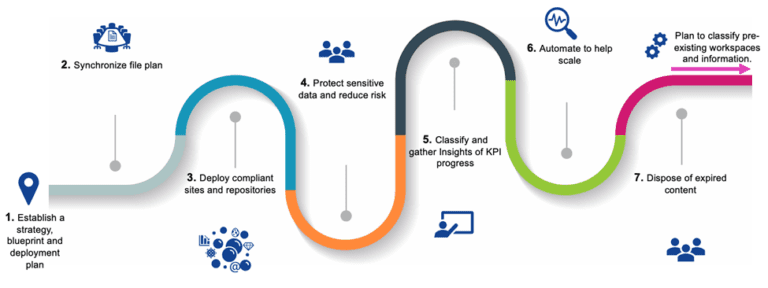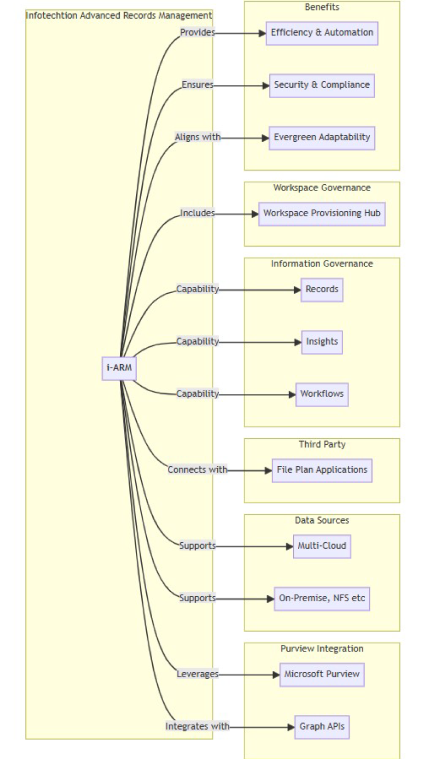![]()

Quick Summary:
- Information governance is an essential tool for every organisation to meet their legal, regulatory and business data compliance requirements.
- Microsoft cloud is creating new complex Information governance challenges.
- Microsoft cloud provides the infrastructure and controls for information protection and governance.
- 3rd party or custom solutions are required to automate the implementation and operational governance of digital information in Microsoft cloud.
- Organisations adopting a buy (3rd party) over build (custom solutions) strategy to reduce the total cost of ownership (by 40%).
- Infotechtion-ARM add-on for Microsoft cloud provides a single solution to automate operational governance of workspaces, and information across the digital and physical landscape.
As organizations embrace the expanded adoption of data lifecycle and records management, they face several challenges in effectively managing records. The existing capabilities of handling records across Microsoft 365 and other platforms fall short in providing the necessary tools and insights leading to potential compliance risks, inefficiencies, and operational bottlenecks. While working towards a seamless governance structure, organizations encounter the following challenges:
- Complex Workspace Governance: The current workspace creation and management processes lack flexibility and automation, leading to a cumbersome and manual approach. Administrative tasks related to workspace approval, lifecycle management, and policy enforcement are prone to inefficiencies, posing a barrier to a streamlined operational landscape.
- Inadequate Insights for Decision-Making: Organizations struggle with obtaining comprehensive insights into their records landscape. The absence of a centralized, user-friendly dashboard leaves decision-makers in the dark, impacting their ability to make informed choices about records-related activities.
- Unstructured Review Assignments: The conventional approach to assigning reviewers for records lacks a strategic touch. Without a systematic assignment based on location or business unit, organizations face challenges in ensuring that the right individuals are reviewing the pertinent data.
- Limited Flexibility in Metadata Display: Current records management systems fall short in providing the necessary flexibility in metadata display. Organizations are constrained by default metadata views, inhibiting their ability to tailor data displays according to specific needs and requirements.
- Inefficient Search and Retrieval Processes: Navigating through a vast sea of records becomes a time-consuming task due to the lack of intuitive search and filter tools. This inefficiency not only impacts productivity but also increases the risk of oversight and errors in data retrieval.
- Challenges in Disposition Management: The absence of an efficient management and tracking of dispositions complicates the entire lifecycle management process for organizations. With the increase in volume and complexity of records handling records disposition poses risk of oversight and hampers the meticulous and strategic approach required for effective records lifecycle management.
- Fragmented Multi-Cloud Integration: Organizations encounter difficulties in extending data scanning capabilities across various cloud sources seamlessly. The lack of alignment with multi-cloud roadmaps, especially with Microsoft Purview, results in a fragmented approach to data governance.
- Missing Integration with File Plan Management Products: Connecting with third-party file plan management applications for seamless compliance remains a manual and effort-intensive process. Aligning with legal and regulatory changes becomes challenging, leading to potential compliance gaps.
- Ineffective Tracking of Labelling Activities: The complexity of labelling activities across different platforms poses a significant challenge. Organizations struggle to efficiently track and manage the labelling processes associated with records, leading to potential errors, misclassifications, and security risks.
- Complexities in Physical Records Management: Integrating physical records poses challenges, particularly in streamlining requests and digitization workflows. The existing gap between physical and digital records management inhibits a smooth transition.
How Infotechtion’s i-ARM Solves the Problem: To address the above challenges, Infotechtion has built a revolutionary solution i-ARM, that not only streamlines records management but also introduces efficiency, flexibility, and security across various facets of data governance. i-ARM empowers organizations to adapt seamlessly to the ever-changing digital and physical landscape while ensuring compliance, security, and operational efficiency. Discover the distinctive features that set i-ARM apart, providing organizations with a robust and efficient approach to records management.
- Workspace Governance: i-ARM offers user-led creation of workspaces with configurable workflows to manage the approval process, ensuring ongoing operational governance, including lifecycle management. i-ARM introduces automated governance rules by streamlining administrative tasks. This includes automated approval workflows, policy enforcement, and consistent application of governance rules to maintain order and compliance.
- Insights Dashboard: i-ARM’s user-friendly dashboard aggregates valuable insights, offering a snapshot of the records landscape. This feature enhances decision-making by providing a comprehensive overview of records-related activities.
- Personalized Review Assignments and Disposition Management: i-ARM’s strategic approach allows organizations to configure their reviewer assignments based on location or business unit. This not only streamlines the review process but ensures that the right eyes are on the right data. The staged approach to disposition management, allowing organizations to handle the process in multiple stages. This ensures a meticulous and strategic approach to records disposition.
- Flexibility in Metadata Display: Beyond default metadata, i-ARM offers the flexibility to showcase and enrich custom metadata alongside, providing a nuanced view of information. This feature empowers organizations to tailor data views according to specific needs.
- Easy Searching: With i-ARM, finding and getting information is a breeze. The simple search and filter tools, connected with Microsoft Search, make it quick and straightforward. No more spending a lot of time and effort on these tasks!
- Seamless Multi-Cloud Integration: i-ARM extends data scanning and records management capabilities across various cloud sources, aligning perfectly with Microsoft Purview’s multi-cloud roadmap. This ensures a comprehensive approach to data governance.
- Easy Connections for Retention: Connect smoothly with external file plan management products for automated creation and configuration of retention. Stay up to date with laws and regulations, making sure your policies are right across all systems.
- Simplified Physical Records Lifecycle Management: i-ARM seamlessly integrates physical records into Microsoft 365, streamlining requests and digitization workflows. This not only enhances accessibility but bridges the gap between physical and digital records.
Key Benefits: Empowering Your Data Governance Journey
- Automation and Integration: i-ARM leverages Microsoft Purview and Graph APIs to automate records management. This includes the integration of auto-classification policies and process automation, reducing manual intervention.
- Security and Compliance Assurance: Native integration with Microsoft 365 ensures top-tier data security and compliance with cybersecurity and information risk management requirements. i-ARM provides a secure environment for managing sensitive data.
- Evergreen Adaptability: i-ARM aligns seamlessly with the Microsoft 365 roadmap, ensuring that it evolves in tandem with changes in the platform. This evergreen model future-proofs your data governance strategy.
- Simplified Operational Governance: i-ARM simplifies the establishment of rules and policies, seamlessly integrating with Microsoft 365 administrative policies. This consolidation of governance tasks enhances operational efficiency.

Stay tuned for upcoming blogs where we’ll delve into each challenge and explore how i-ARM solves them. Join us on a data governance journey where efficiency meets innovation. If you want to know more about i-ARM, reach out to us at contact@infotechtion.com.



